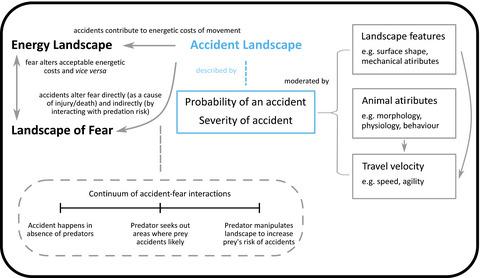当前位置:
X-MOL 学术
›
Ecol. Lett.
›
论文详情
Our official English website, www.x-mol.net, welcomes your feedback! (Note: you will need to create a separate account there.)
Accidents alter animal fitness landscapes
Ecology Letters ( IF 8.8 ) Pub Date : 2021-03-09 , DOI: 10.1111/ele.13705 Rebecca Wheatley 1 , Jessie C. Buettel 1 , Barry W. Brook 1 , Christopher N. Johnson 1 , Rory P. Wilson 2
Ecology Letters ( IF 8.8 ) Pub Date : 2021-03-09 , DOI: 10.1111/ele.13705 Rebecca Wheatley 1 , Jessie C. Buettel 1 , Barry W. Brook 1 , Christopher N. Johnson 1 , Rory P. Wilson 2
Affiliation

|
Animals alter their habitat use in response to the energetic demands of movement (‘energy landscapes’) and the risk of predation (‘the landscape of fear’). Recent research suggests that animals also select habitats and move in ways that minimise their chance of temporarily losing control of movement and thereby suffering slips, falls, collisions or other accidents, particularly when the consequences are likely to be severe (resulting in injury or death). We propose that animals respond to the costs of an ‘accident landscape’ in conjunction with predation risk and energetic costs when deciding when, where, and how to move in their daily lives. We develop a novel theoretical framework describing how features of physical landscapes interact with animal size, morphology, and behaviour to affect the risk and severity of accidents, and predict how accident risk might interact with predation risk and energetic costs to dictate movement decisions across the physical landscape. Future research should focus on testing the hypotheses presented here for different real‐world systems to gain insight into the relative importance of theorised effects in the field.
中文翻译:

事故改变了动物的健康状况
动物会根据运动的能量需求(“能量景观”)和掠食的风险(“恐惧景观”)改变栖息地的使用方式。最近的研究表明,动物还选择栖息地并以使其暂时失去活动控制的机会最小化的方式活动,从而遭受滑倒,跌倒,碰撞或其他事故的影响,尤其是在后果可能很严重(造成伤害或死亡)的情况下。我们建议动物在决定何时,何地以及如何在日常生活中移动时,应对“事故景观”的代价以及掠夺风险和精力充沛的代价。我们开发了一种新颖的理论框架,描述了自然景观的特征如何与动物的大小,形态和行为相互作用,从而影响事故的风险和严重性,并预测事故风险如何与捕食风险和高能成本相互作用,以决定整个自然景观中的移动决策。未来的研究应着重于检验此处针对不同的现实世界系统提出的假设,以深入了解理论效果在该领域的相对重要性。
更新日期:2021-04-14
中文翻译:

事故改变了动物的健康状况
动物会根据运动的能量需求(“能量景观”)和掠食的风险(“恐惧景观”)改变栖息地的使用方式。最近的研究表明,动物还选择栖息地并以使其暂时失去活动控制的机会最小化的方式活动,从而遭受滑倒,跌倒,碰撞或其他事故的影响,尤其是在后果可能很严重(造成伤害或死亡)的情况下。我们建议动物在决定何时,何地以及如何在日常生活中移动时,应对“事故景观”的代价以及掠夺风险和精力充沛的代价。我们开发了一种新颖的理论框架,描述了自然景观的特征如何与动物的大小,形态和行为相互作用,从而影响事故的风险和严重性,并预测事故风险如何与捕食风险和高能成本相互作用,以决定整个自然景观中的移动决策。未来的研究应着重于检验此处针对不同的现实世界系统提出的假设,以深入了解理论效果在该领域的相对重要性。



























 京公网安备 11010802027423号
京公网安备 11010802027423号